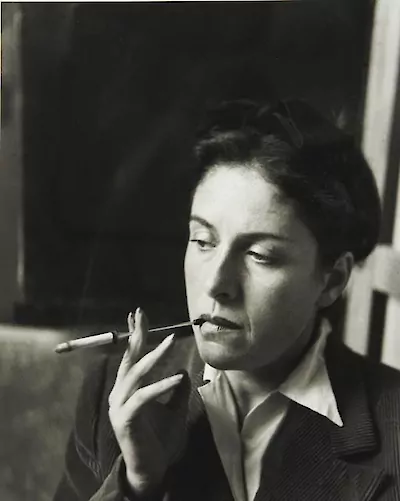Dora Maar
Fearsome interiors




Surrealism is usually closer to reality than you’d think. Objects, twisted or juxtaposed, but recognizable. Dali had his melting clocks and tall elephants, Magritte his optical illusions, Max Ernst his warped landscapes, but take a look at the image above—what the hell is it? It’s a photograph, of course, which makes it much more unsettling. Surreal paintings flow from the imagination to the brush, allowing depictions of the fanciful or impossible, but a photograph from the 1930s should play by the rules. They didn’t have photoshop yet! Yet here’s an impossible, alien figure. Claws, floppy ears, a shapeless ovoid face.
The photo is called “Portrait of Ubu” and it’s my favorite work by the surrealist artist Dora Maar. Maar was her own kind of alien, raised by her Croatian father and French mother in Burma’s Aires Argentina, in a devout Catholic household. Maar was left handed, but her parents forced to write and eat with her right hand. She painted with her left, secretly. At 18, Maar left Argentina for Paris, where she studied first painting, then photography at the École de Photographie de la Ville. She was smart, strange, and beautiful, and soon sank into the hallucinatory world of Paris cafe culture, mingling with intellectuals, artists, and weirdos. Soon Maar shared a studio with the set designer Pierre Kéfer, posed for Man Ray, and took photos for the art historian and Louvre curator Germain Bazin. The legendary street photographer Henri Cartier-Bresson encouraged her to pursue documentary photography, and she worked closely with the Hungarian photographer Brassai, before opening her own studio at 29 Rue d'Astorg in the eighth arrondissement of Paris.
By the 1930s Maar was a fixture in the surrealist community. It was an extremely male-domininated scene, and Maar was both deeply respected for her poetic, visionary approach to photography and fetishized as a mysterious and powerful female presence. The Critic Julie L'Enfant noted that “her lighting of a cigarette could be a theatrical event” and her beautiful hands and voice were topics of obsessive discussion among the surrealist boys club. Read anything by Breton or Dali—this was a very creepy crew, but Maar held her own, until she met Picasso.
The story goes that Maar posted up at a cafe she knew Picasso frequented, sitting at a table and playing Bishop, the game where a knife is stabbed between fingers faster and faster until blood is drawn. Picasso asked her for the bloodstained gloves she wore, adding them to his cabinet of morbid curiosities, and the two fell into a turbulent love affair. It was a terrible relationship. Picasso was physically abusive, and painted Maar in a series of callous portraits as a ‘weeping woman’ distorted by tears of anguish and frustration. Maar pointedly rejected these depictions, saying “all portraits of me are lies. They're Picassos. Not one is Dora Maar.” Picasso was a domineering partner, belittling Maars photographic work as being inferior to painting. Maar gave up photography, and as their relationship fell apart and Picasso left her to chase (and eventually destroy the career of) Francoise Gilot, Maar’s mental health declined dramatically.
In 1944, Maar was committed to the controversial Sainte Anne’s asylum, where she was treated with electroshock therapy. The psychologist Jacques Lacan attempted to ground her, guiding her on a desperate journey through belief frameworks, from occult to Buddhist, and eventually back to her familial Catholicism, saying “I had to stabilize her. She needed something to crystalize upon. It came to a choice between the confessional and the straitjacket.”
I hesitate when telling stories like this. It’s easy to support the patriarchal narrative of fragile, alluring women consumed by genius men, as if it’s part of some twisted natural order, adding to the already overblown legacy of the ‘alpha male.’ Fuck that. Picasso was a gross, destructive psychopath, who leveraged his fame to consume and ritually destroy the women in his circle. When he and Maar connected Picasso was already one of the most powerful and influential men in the world. His fame, wealth, and narcissism created a power differential capable of annihilating even incredibly strong people. Imagine dating Elon Musk or Jeff Bezos and coming out with your identity and sanity intact.
After her treatment at St Anne’s, Dora Maar became a recluse, painting moribund landscapes and still lifes, emerging from her home in Ménerbes only to go to the local church. To survive Maar sold off the relics of her relationship with Picasso, sketches drawings and paintings, and on her death in the bizarrely recent 1997, her full archive of grim memorabilia was auctioned for tens of millions, including paper smeared with Picasso’s blood, ostensibly drawn from a ring he commissioned for Maar that featured her portrait on the outside, and a metal spike on the inside.
For decades Maar was described as a muse, but since the 2000s her work has been re-examined and shown at Haus der Kunst in Munich, the Centre Pompidou in Paris and the Tate Modern in London, rebuilding the narrative of a visionary with a camera, and an eye for the alien, the unnerving, and the truly surreal.
...
Got questions, comments or corrections about Dora Maar? Join the conversation in our Discord, and if you enjoy content like this, consider becoming a member for exclusive essays, downloadables, and discounts in the Obelisk Store.